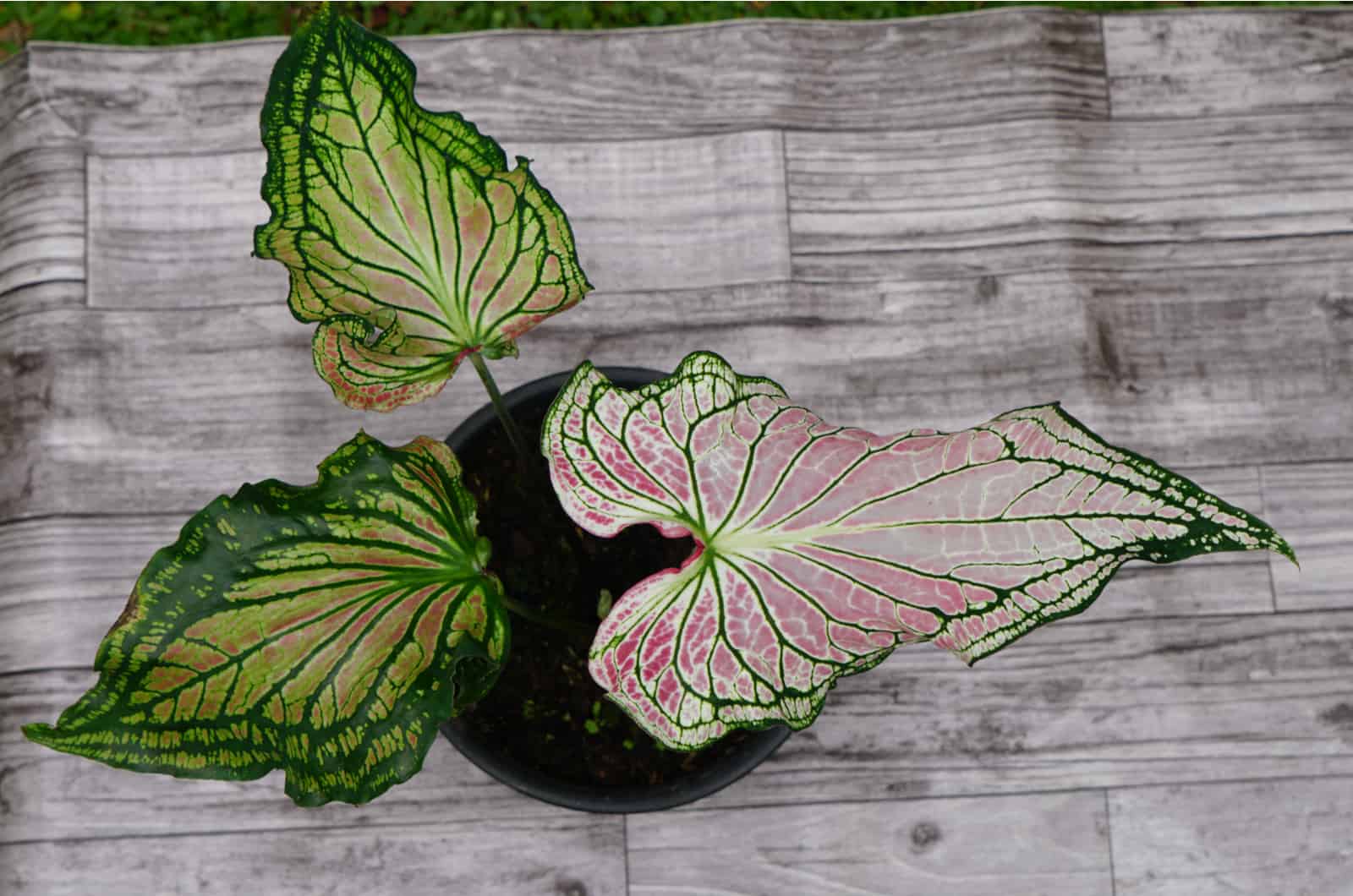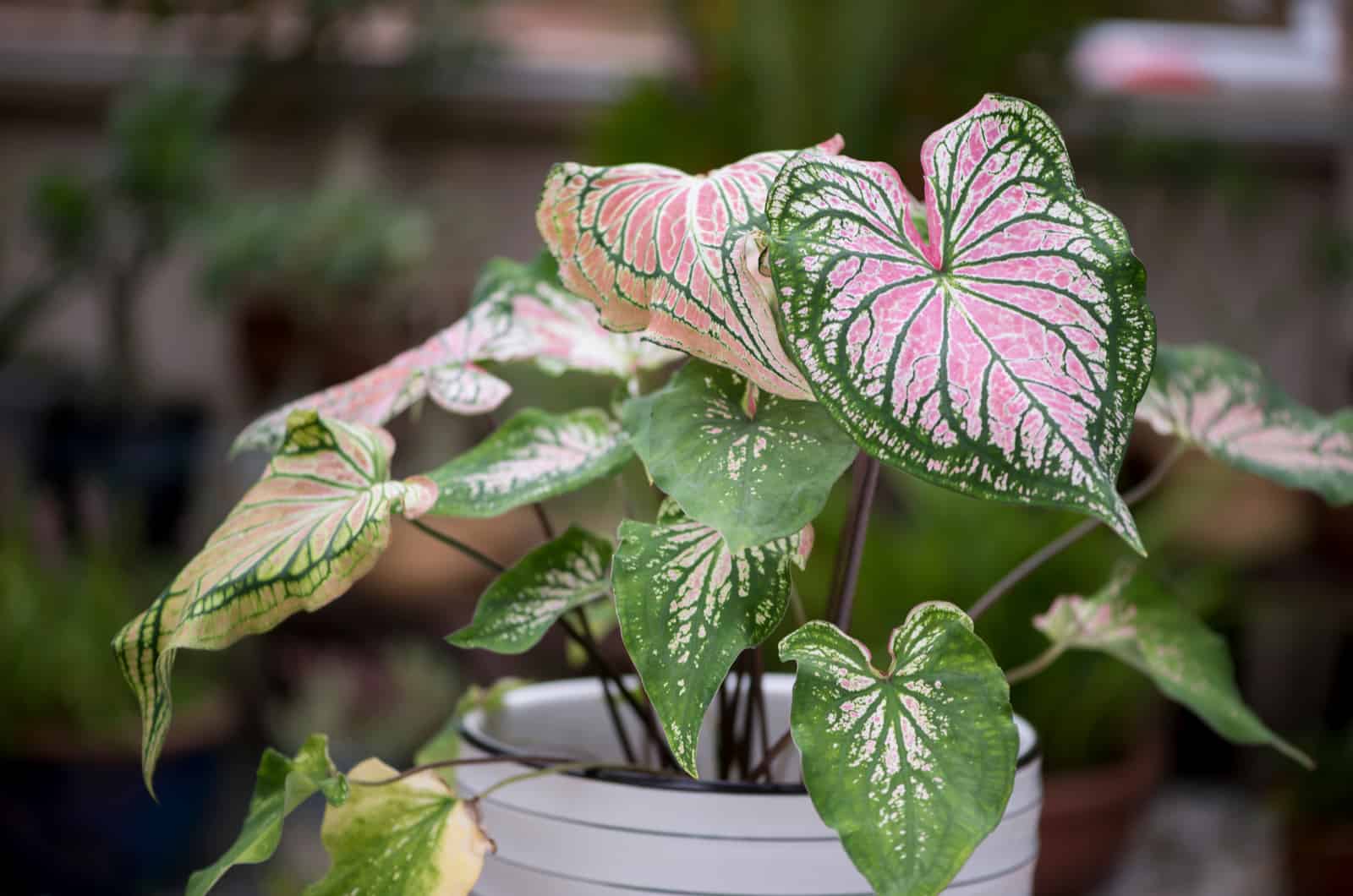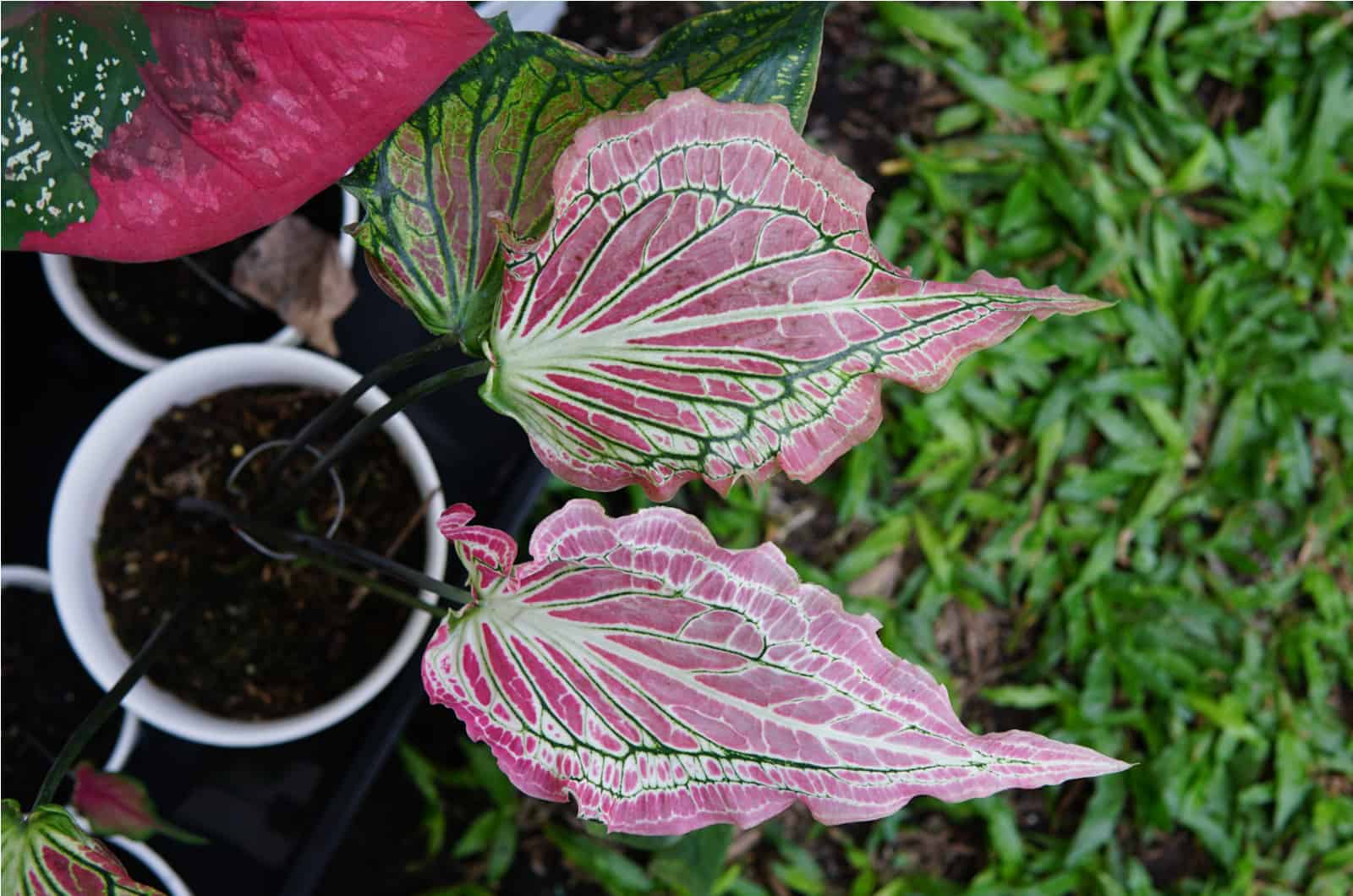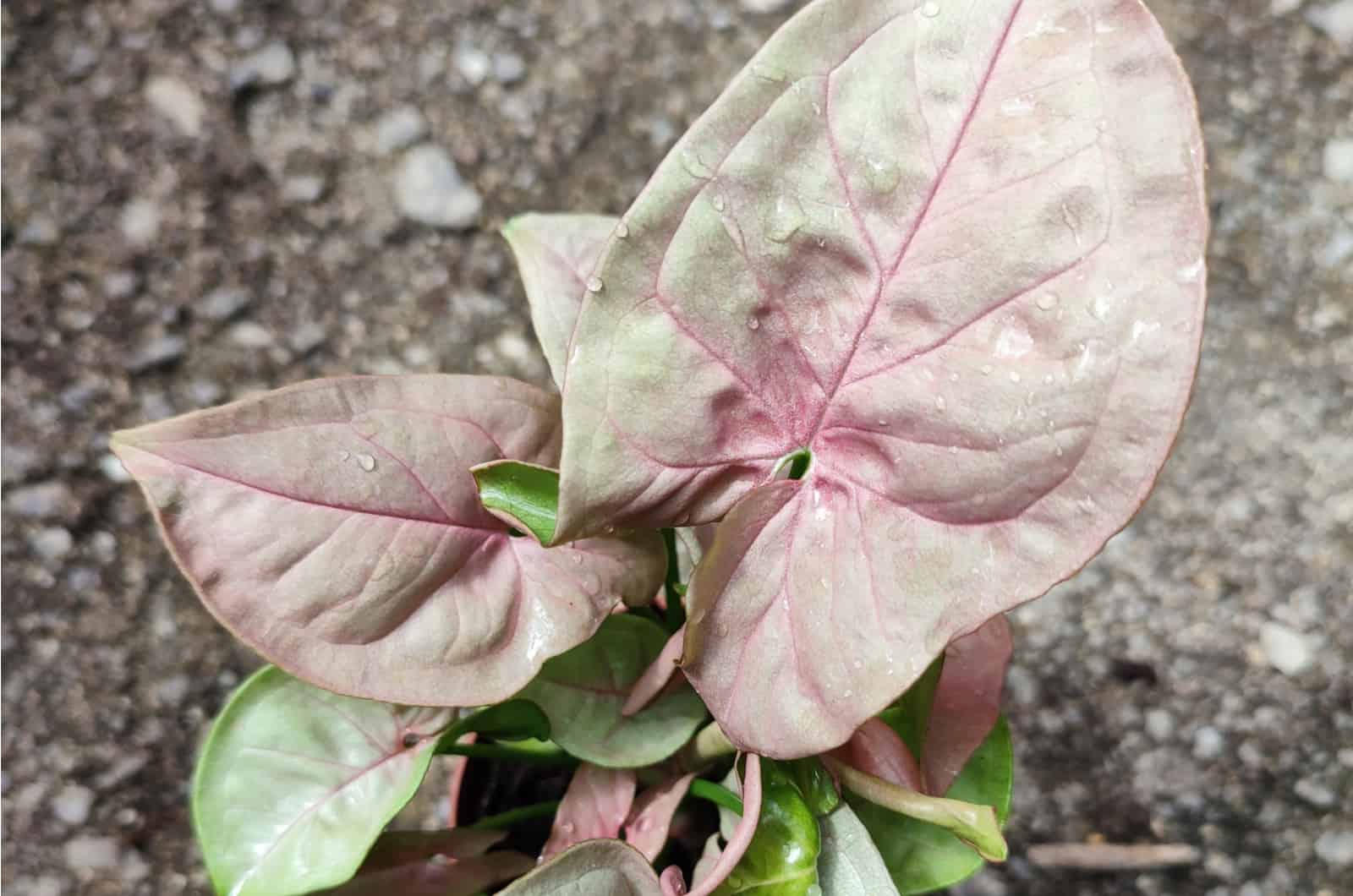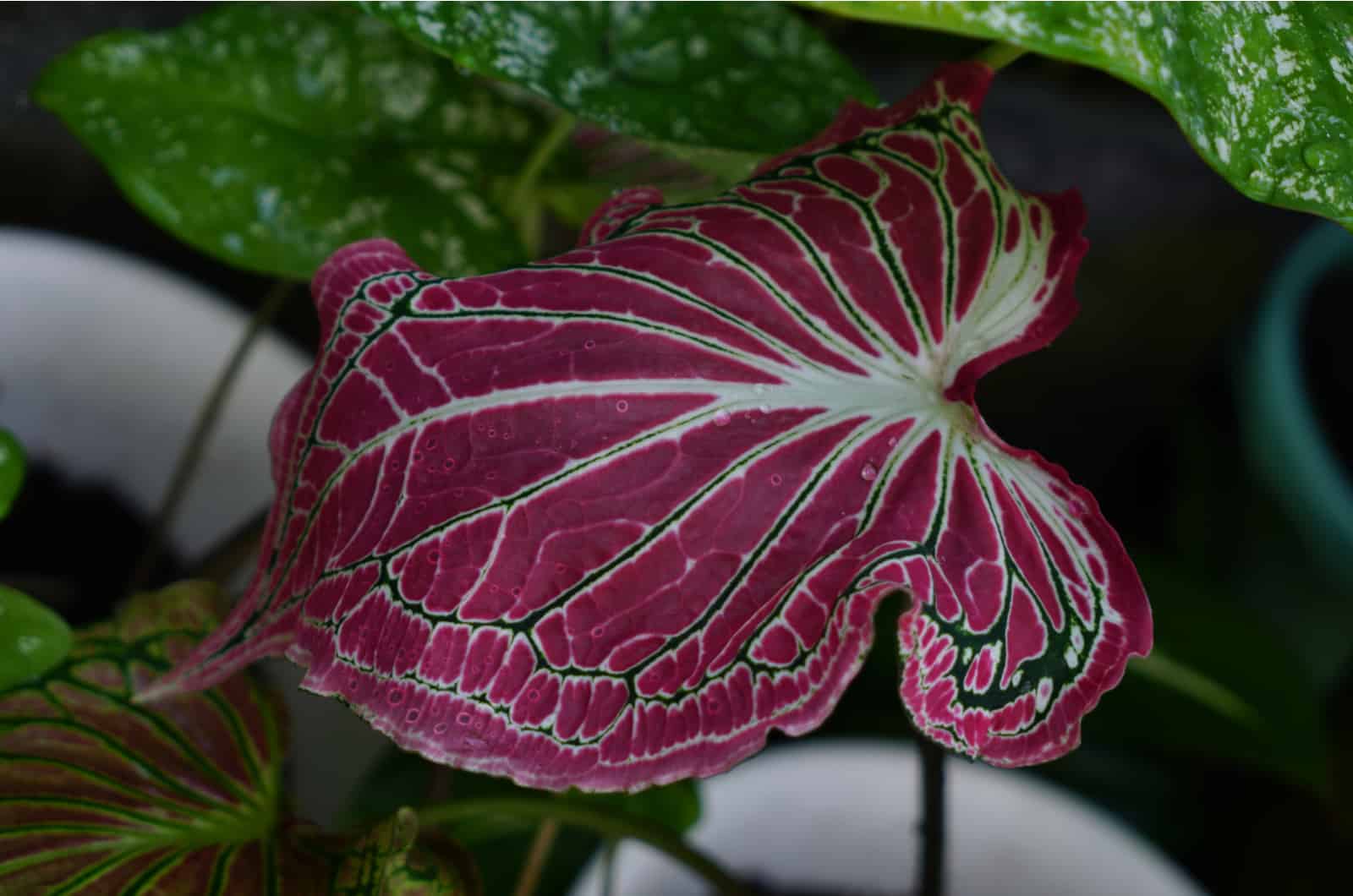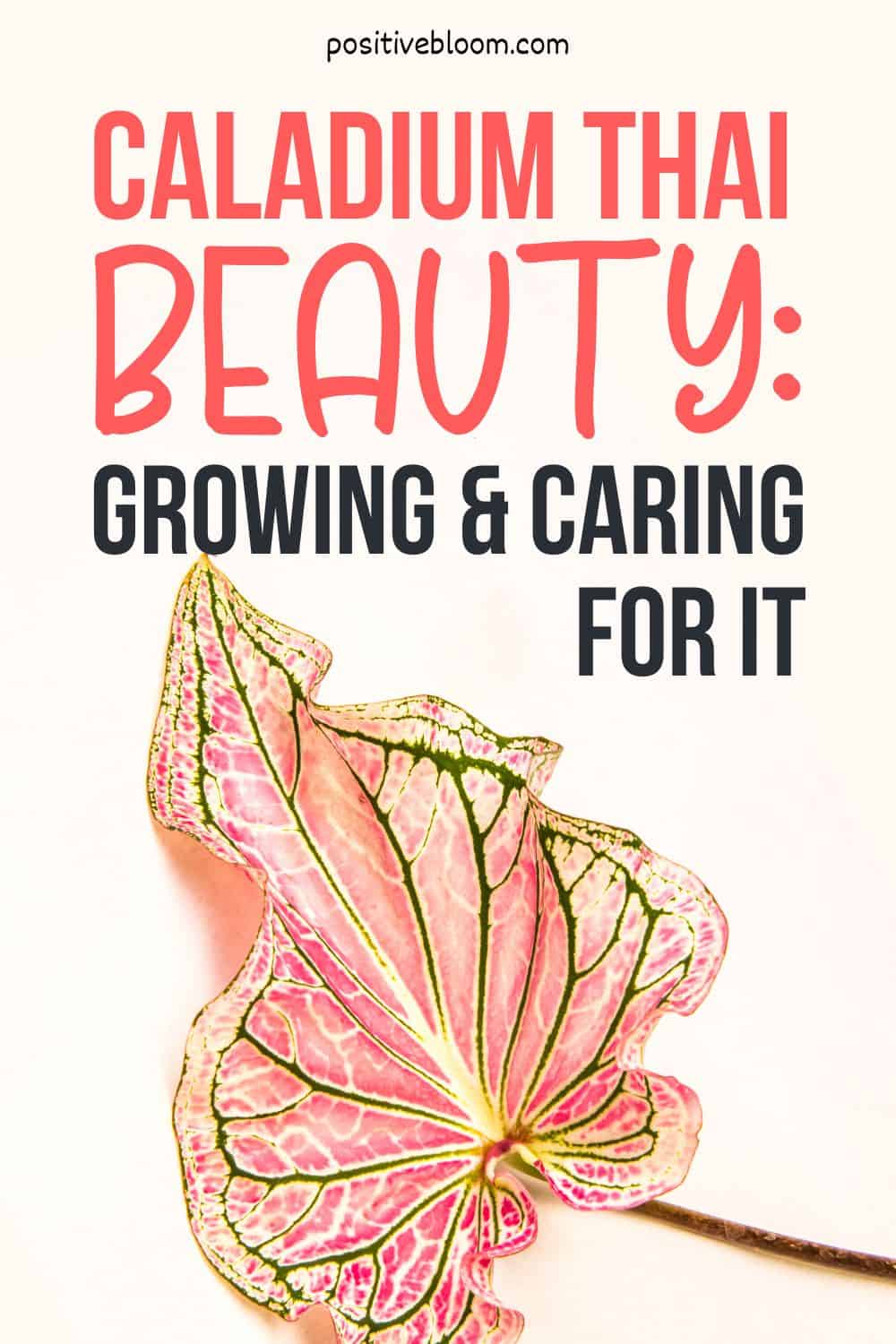There are over 1000 Caladium cultivars, and plant lovers mainly grow them outdoors.
They are known for their exceptional foliage. One of the cultivars is a stunning Caladium Thai Beauty. This striking plant is grown as a hybrid in Thailand, and it was made specifically for the royal family. The locals gave it the name Hok Long.
A Thai Beauty will make a great addition to your home decor, especially if you are a fan of the color pink. The word ‘Beauty’ in the plant’s name is not given by accident. Due to the pink foliage with a great pattern of green veins, the plant got its place on the list of the most beautiful plants to grow in your home.
The Thai Beauty Caladium is a low-maintenance plant, and if you are lucky enough to find this rare plant, you won’t have any problems taking care of it.
Before we move on, let’s see some basic info.
[table id=107 /]What Does The Caladium Thai Beauty Look Like?
Many plant growers claim that Caladiums are must-have plants. There are many reasons for this; their appearance is undoubtedly one of the main ones.
Let’s see more!
Appearance
The fancy leaves of the Thai Beauty inspired the growers to name the plant the Fancy-Leaved Caladium. It has pink variegated foliage with fascinating green veins. This is not all; the leaves are heart-shaped, which gives the plant one more specific feature.
I have to mention that the leaves are only green in the plant’s early stages, but as the plant matures, they turn pink (how remarkable, right?!).
You can see the leaves in their full beauty from spring to fall.
No wonder the royal family demanded such a plant.
It combines with succulents, cacti, philodendrons, and even alocasia plants perfectly.
Growth
This plant is a perennial, which means that you can see its shoots peeking from the soil in early spring. As the plant is evergreen, it will function well in fall too.
As the temperatures rise, the growth of this plant accelerates.
You might be disappointed if the plant is exposed to lower temperatures during dormancy, as this means it won’t grow as well.
The leaves will probably fall off and die back during the plant’s dormancy period. The chance of the leaves falling off increases if you live in colder climates.
This Caladium plant grows up to 9 inches, which means that its growth habit resembles a pothos.
On the other hand, the leaves can grow up to 5 inches.
This fast-growing hybrid produces new leaves every month.
If you grow an Angel Wings plant outside, I suggest planting them in a pot. It’ll be easier to move it inside if needed and also to move it to a spot with better conditions (light and soil).
How To Care For The Caladium Thai Beauty?
The Angel Wings is not a demanding plant and follows the same care guide as other elephant ears plants. It will thrive in warmer temperatures and partial shade, and it requires moderate watering and well-draining potting soil.
Another great thing about this plant is that it can be propagated.
Let’s get into some details!
Humidity Requirements
The Thai Beauty Caladium is a tropical plant, which is why it appreciates high humidity. I suggest you mimic these conditions if you grow this Caladium as an indoor plant.
If the humidity drops below 40%, the plant might lose what makes it unique, its coloration.
As we live in the age of technology, we often have air conditioners and vents in our homes. These two are the enemies of this Caladium plant.
You can increase the humidity in two ways: using a humidifier or placing a pebble tray below the plant’s pot.
Additionally, you can increase the humidity by placing your Angel Wings next to other plants.
Move your Thai Beauty plant next to your orchids, philodendrons, or other Caladiums such as Xanthosoma lindenii, if you have them.
Kitchens and bathrooms have a higher humidity, so some gardeners suggest moving the plant to those rooms. It is believed that these rooms will prevent the plant from going into dormancy.
You should let the plant go through the dormancy stage though, as it certainly needs some rest after the growing season.
During dormancy, a Pink Cloud doesn’t use its carbohydrate stores, which means that the plant will have more strength to grow and thrive during the growing season.
Temperature Requirements
Due to its native habitat, an Angel Wings prefers higher temperatures (only slightly higher, as we don’t want to burn the plant).
The plant thrives in temperatures over 65 °F. The Fancy-Leaved Caladium doesn’t withstand colder temperatures. This is essential to know if you live in climates where there is a possibility of frost during the spring. If the plant is affected by frost, it has no chance of recovery.
If you live in such climates and grow this Caladium outdoors, I suggest you move the plant indoors before the first frost (make sure to store the tubers in low light).
Another essential thing to mention is that the temperature shouldn’t drop below 45 °F during the dormant period. This would affect the Thai
Beauty’s growth in the next growing season, and it would sprout 6 weeks later than usual.
If you place the plant indoors, make sure it’s far away from heating sources such as fireplaces and radiators.
Light Requirements
The plant is native to the tropics and grows under the rainforest canopy. This means that the plant isn’t exposed to direct sunlight.
The plant thrives in partial shade, indirect light, to be precise. If you grow it as a houseplant, you can put curtains on the window to achieve shade.
However, you need to expose an Angel Wings to direct sunlight for a short time. This works for other Caladiums with thicker leaves, such as the Caladium Candidum.
If you grow this plant outdoors, place it under a tree if you have one. This way, you will ensure enough sunlight but also avoid sunburns which are extremely dangerous for all Caladium plants.
You can always use a light meter if you are not sure that the plant is receiving enough light.
Only the tubers require low light when placed indoors over the winter.
Soil Requirements
A good potting mix is essential for the Thai Beauty plant to thrive.
You should ensure 3 conditions when it comes to the potting mix for the Caladium Thai Beauty.
1. It should have a good drainage system to drain entirely between waterings.
2. It should hold moisture.
3. It needs to have an appropriate pH level.
The ideal potting mix has a good drainage system that holds moisture well and is a combination of potting soil and peat (1:1).
Additionally, adequate potting soil should be slightly acidic (pH 6.0).
If you decide to grow a Fancy-Leaved Caladium outdoors, there’s a way to check if your garden fulfills all the requirements. Choose a few spots in the garden and check the soil of each spot 6 hours after heavy rain. If the soil on the spot is waterlogged (has pooling around it), don’t plant your Thai Beauty there.
The problem with waterlogged soil is that it can cause the underground tubers to rot.
I suggest you choose a spot that has the smallest pooling around it. If you can’t find any without any pooling, add some organic material to the soil where you decide to grow the plant, this will improve the drainage.
Watering
All Caladium plants require a similar watering schedule. These plants grow along the banks of the rivers in the rainforests, which is why the soil should be constantly wet.
I don’t mean waterlogged (they grow along the banks, not in the river), your goal should be to keep the soil moist but not overwatered. Wait until the soil dries out before watering it.
Don’t worry too much about underwatering; the plant is drought-tolerant. It stores water in its leaves and stems and will go into dormancy if it’s not watered for a more extended period. This is a defensive mechanism to protect itself from drought.
However, the plant usually goes into dormancy during winter. Never water the plant during dormancy because it doesn’t grow during that period, so the chances of overwatering it are high.
I suggest you water the plant once per week. However, delay watering it during winter and then continue in the spring.
Always pay attention to the soil before you water it. Waterlogged soil causes more trouble than underwatering does.
If you grow the plant outdoors, check the water pooling around it, especially if you often leave it in an area with frequent rainfalls.
Fertilizing
The Fancy-Leaved Caladium is a food lover, and it requires fertilization every 9 days during the growing season.
I think this is one of the most demanding houseplants in terms of feeding.
This plant despises fertilizers rich in nitrogen. Therefore, choose a fertilizer with lower concentrations of nitrogen. Higher concentrations burn the roots, and the pink leaves will no longer be pink.
Another essential thing to mention is that you should water the plant before adding any fertilizer.
One more thing, don’t fertilize a Thai Beauty Caladium during dormancy as the plant doesn’t grow.
Propagation
Thai Beauty plants are easily propagated through their tubers. Always take tubers in early spring to achieve the best results.
Here are 6 steps to propagate the Caladium Thai Beauty.
1. Using a sterilized sharp knife, cut a tuber from the Thai Beauty’s roots. Make sure the tuber has a few roots attached.
2. Fill a container with an appropriate potting mix.
3. Make a hole in the center of the potting mix and place in the tuber.
4. Gently press the soil around the tuber and water it. Place it in bright, indirect light.
5. New growth should occur within a few weeks.
6. Plant the roots into the original pot.
The best time to take a tuber for propagation is while you’re repotting, so there’s no need to take the Angel Wings plant out of the pot more than once.
Remember that new growth can be accelerated if you ensure the proper conditions after the propagation process.
Pruning
The Thai Beauty plant doesn’t require much pruning. However, it is necessary if you notice dead or yellow leaves before the growing season. Prune dead foliage after removing corm from the ground or potting mix, to encourage active growth and more branching.
I suggest you prune once a year to make more room for new growth and buds.
I need to remind you to sterilize your pruners each time you use them as an Angel Wings plant may suffer from deadly infectious diseases. I use 70% isopropyl alcohol or ethanol for sterilization.
Repotting
The Caladium Thai Beauty should be repotted after it outgrows its pot. This is a fast-growing plant, and you’ll probably need to repot it more often compared to other, more common, houseplants.
Another indicator to repot is when the roots start growing from the drainage holes. I suggest choosing a slightly bigger pot (about 2 inches) when repotting. If the pot size is larger than preferred, it will contain more soil around the tubers, increasing the chances for the tubers to rot.
You should use fresh soil each time you repot.
Common Issues
Even if you ensure all the ideal conditions for the plant to thrive, some issues may still occur. Luckily, Caladium plants aren’t prone to many diseases.
Fungus
Underground tubers are often affected by Rhizoctonia and Pythium. These fungi eat out the plant, so you have to pay attention to spotting them on time.
Unfortunately, you can’t just leave the plant out over winter, hoping that the fungus will die away. It can live in dormant tubers and attack as soon as the growing season begins.
Solution: Before storing the tubers in winter, place them in hot water. To do this, heat the water to around 120 °F. Then, put the tubers in the hot water and leave them to soak for about 30 minutes.
Before you store the tubers, leave them to dry out entirely.
Brown Patches On The Leaves
Suppose you expose your Caladium Thai Beauty to direct sun. In this case, its delicate leaves will develop brown patches which look like sunburns.
Solution: Move the plant to where it won’t be exposed to direct sun. Place it in a shady area. Remove the leaves with brown patches. Luckily, the subsequent leaf growth won’t be disrupted.
Pests & Animals
The Thai Beauty Caladium isn’t prone to many insects. However, ragged or small leaves will mean that you have company. Look for caterpillars (they are usually the culprits).
Solution: Gently remove them by hand.
If you grow an Angel Wings as an indoor plant, you can expect aphids to come for a visit. They choose the undersides of the leaves and leave a sticky substance.
Solution: Dip a cloth in neem oil or rubbing alcohol and gently rub the leaves.
If you grow an Angel Wings plant outside, grasshoppers will pay a visit. These insects seem to enjoy visiting Caladium plants.
Solution: Grasshoppers love you, Thai Beauty; birds love grasshoppers! Make sure to keep some birds around your plant. I promise you won’t have any issues.
As far as the animals are concerned, rabbits, deer, and squirrels are fans of a Thai Beauty’s tuber, so watch out for these little rascals.
Solution: Fence the area around an Angel Wings plant to protect the plant from deer and rabbits. Sneaky squirrels can be repelled by placing wire over the tubers.
Is The Thai Beauty Caladium Toxic?
The Caladium Thai Beauty is toxic to humans and pets, and the entire genus Caladium is known for its toxicity. Their leaves contain needle-like sharp crystals of calcium oxalate.
When a child or pet ingests a leaf, it will release the crystals, and it will cause mouth swelling and diarrhea.
FAQs
What are the risks of growing Thai beauty caladiums?
The main risk of growing Thai Beauty Caladiums is toxicity. This plant, as well as other Caladiums, contains harmful chemicals which are poisonous to humans and pets. Monitor little children or pets if they are near the plant. Another risk is if the plant suffers from some disease or has pests on the leaves, it can easily transmit them to other plants. Make sure to isolate the plant if you spot any changes.
What are the benefits of caladiums?
Caladiums are easy-to-grow plants. They are tropical plants, so ensure higher temperatures and humidity, partial shade, slightly acidic and well-draining soil, and water once a week. During winter, the plants go through dormancy, so you don’t have to worry about them during the colder periods. Just keep them away from frost.
Wrapping Up
I suggest you add a Caladium Thai Beauty to your wishlist. This striking plant will make a great addition to your home decor and won’t take much time to look after. Of course, take precautionary measures as the leaves are toxic.
The plant isn’t prone to many diseases or pests, so I recommend growing this Caladium bicolor if you are a beginner.
The great thing about this Caladium plant is that it can be easily propagated. Follow our steps for propagation and get Thai Beauty babies in no time!
Until next time!
Like this post? Share or pin it for later!

